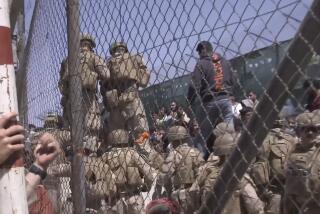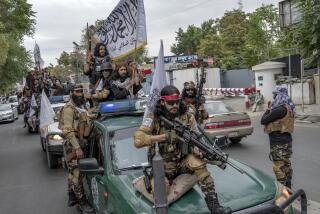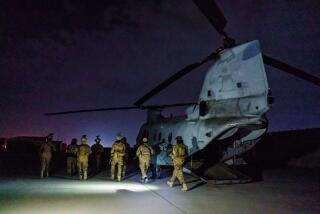Top Afghan defense officials resign after Taliban attack that killed more than 100 soldiers
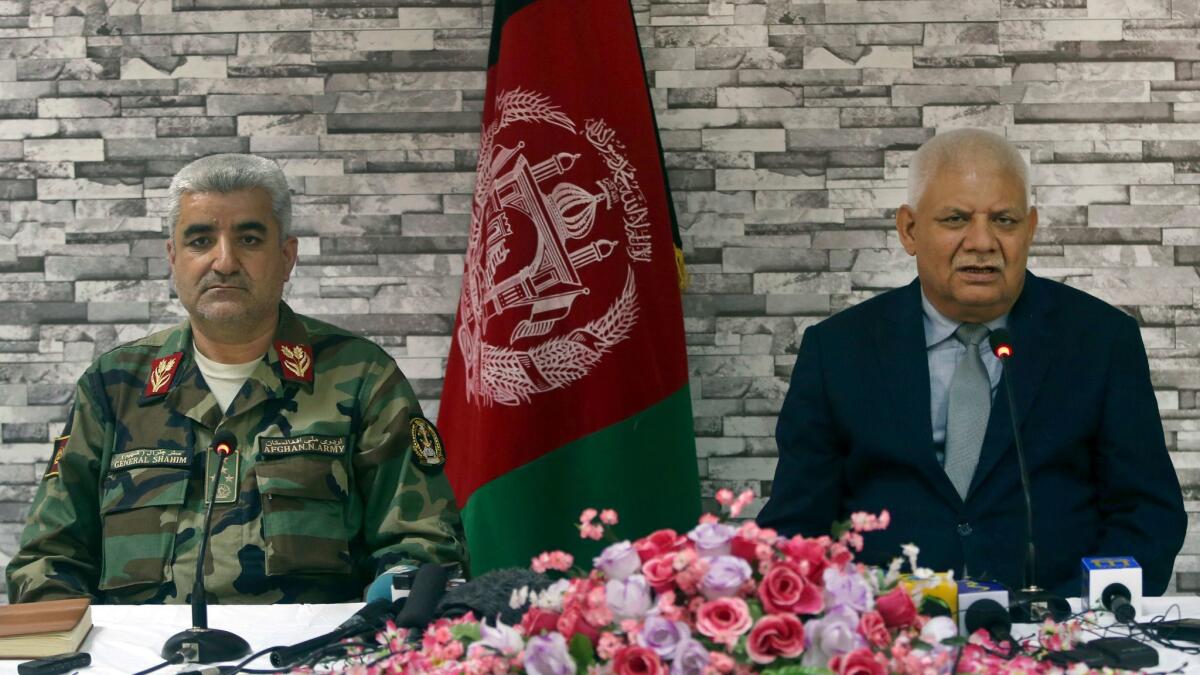
- Share via
Reporting from Kabul, Afghanistan — Afghanistan’s defense minister and army chief stepped down Monday amid growing outrage over the deaths of more than 100 soldiers in one of the deadliest Taliban attacks of the 16-year war.
President Ashraf Ghani accepted the resignations of Defense Minister Abdullah Habibi and Qadam Shah Shaheem, the chief of army staff, in a meeting at the presidential palace, according to a government statement.
Ghani also approved an order to replace the commander of the 209th Corps, the army unit based at the military installation in the northern province of Balkh that was attacked Friday, as well as three other units.
A small group of protesters gathered in Kabul on Monday to criticize the government following the Taliban raid, in which 10 militants wearing army uniforms infiltrated the base and opened fire on soldiers as they were concluding prayers or having lunch. Unconfirmed reports from provincial military officials said more than 140 Afghan soldiers were killed.
About 30 U.S.-led military coalition troops were on the base at the time but were not harmed, a Pentagon spokesman, Capt. Jeff Davis, said Monday.
Some of the Afghan demonstrators’ frustration centered around Ghani’s appointment of Habibi, who is 65 and was thought by some to be too old for the job. At a news conference he said he resigned for the good of the country and said “we should give a chance to our young, energetic and educated people.”
The resignations came as Defense Secretary James N. Mattis arrived in Kabul on an unannounced visit, becoming the second senior Trump administration official in as many weeks to visit the site of the U.S.’s longest war.
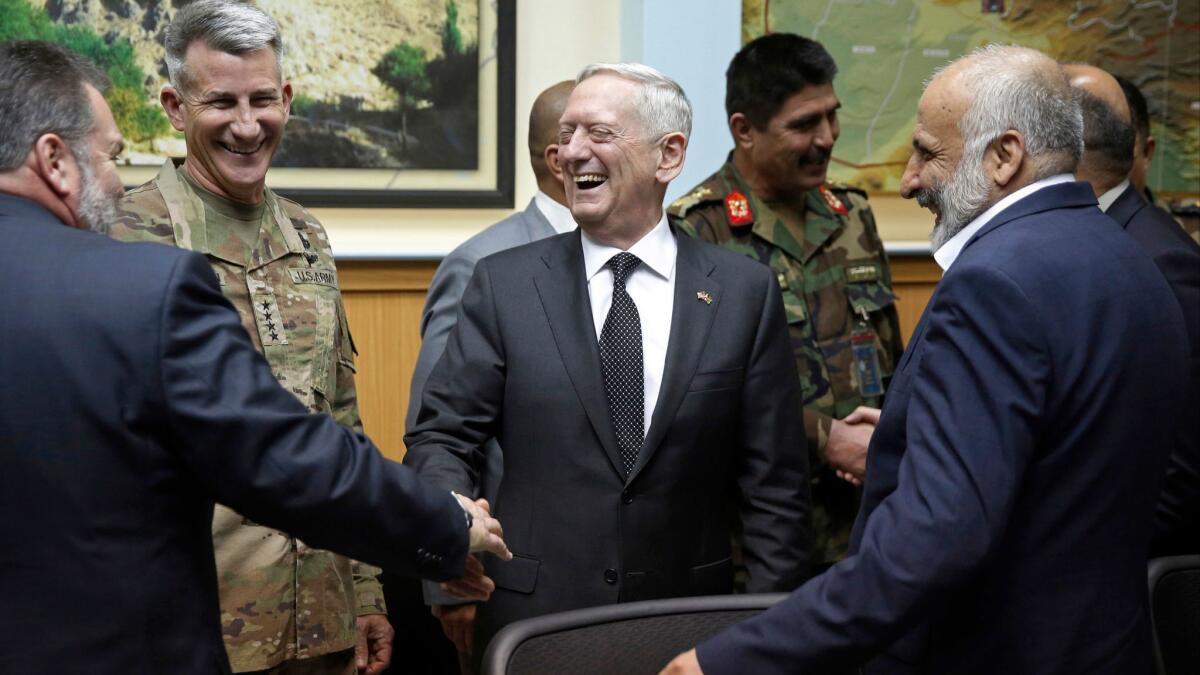
Mattis met with Ghani and U.S. military officials as President Trump considers whether to increase the U.S. military presence in Afghanistan for the first time since President Obama’s 2010 “surge” of tens of thousands of troops.
Speaking with reporters in Kabul, Mattis said he was under “no illusions” about the challenges in Afghanistan and that “2017 is going to be another tough year” for Afghan forces and their international allies.
Gen. John W. Nicholson Jr., commander of U.S. forces in Afghanistan, has said he wants a few thousand more troops to add to the 8,400 U.S. forces stationed in the country. Nicholson told reporters Monday that he was “not refuting” reports that Russia is providing arms to the Taliban, which U.S. officials say is creating new challenges for coalition forces.
Russia has denied providing weapons, saying only that it maintains contact with the Taliban and aims to encourage peace talks.
Last week, Trump’s national security advisor, H.R. McMaster, indicated following a visit to Afghanistan that he would support a U.S. troop increase, saying that “we have reduced considerably the degree and scope of our effort.”
The U.S. mission focuses on advising Afghan forces, conducting counterterrorism operations and carrying out a growing number of airstrikes against Taliban and Islamic State militants.
Two weeks ago, the U.S. military dropped its most powerful nonnuclear bomb, called the Massive Ordnance Air Blast, or MOAB, and nicknamed the “mother of all bombs, on a network of tunnels in eastern Afghanistan that was used by fighters loyal to Islamic State. Afghan officials said that dozens of militants were killed by what the Pentagon refers to as the “mother of all bombs,” but the reports have not been independently confirmed.
Trump has hardly spoken about Afghanistan and failed to articulate a policy for the conflict, but the scale of the bombing suggested that he had given Pentagon commanders freer reign.
While U.S. military officials voice concern about several hundred Islamic State loyalists – many believed to have come from neighboring Pakistan – the far bigger challenge to the Afghan government comes from the Taliban.
The Afghan militant group controls more than 40% of Afghan territory, according to U.S. military estimates, more than at any point since the 2001 U.S.-led invasion, and has inflicted huge numbers of casualties against Afghan forces.
Afghan officials have called on the Trump administration to take action against Pakistan, which they believe provides the Taliban leadership with a haven. A Pakistan-led effort to host peace talks with the Taliban collapsed last year while the militant group continued to gather territory.
Last week’s attack illustrated the need for the Trump administration to increase pressure on Pakistan, Afghan officials said.
“These aren’t village Taliban,” said Daoud Sultanzoy, a former independent lawmaker. “These are well-orchestrated and well-organized attacks and being directed by very sophisticated command and control organizations on the other side of the border.”
Also Monday, a car bomb exploded at an Afghan checkpoint outside a U.S. military facility in the eastern province of Khost. Provincial police chief Faizullah Ghairat said four members of the Afghan security forces were killed and several people wounded.
The base, known as Camp Chapman, was the site of one of the most infamous incidents of the U.S. war, in 2009, when a Jordanian man blew himself up outside a CIA facility on the base and killed seven agency officers and contractors.
Special correspondent Faizy reported from Kabul and Times staff writer Bengali from Mumbai, India. Times staff writer W.J. Hennigan in Washington contributed to this report.
Follow @SBengali on Twitter for more news from South Asia
ALSO
Iran is quiet, for now, in the face of fresh threats from the Trump administration
Civilian casualties from airstrikes grow in Iraq and Afghanistan. But few are ever investigated
UPDATES:
11:55 a.m.: This article was updated with comments from U.S. officials.
This article was originally published at 10:35 a.m.
More to Read
Sign up for Essential California
The most important California stories and recommendations in your inbox every morning.
You may occasionally receive promotional content from the Los Angeles Times.
